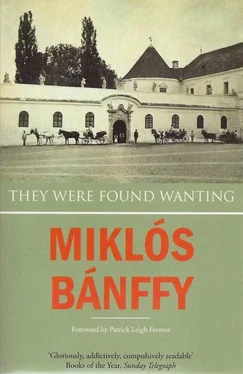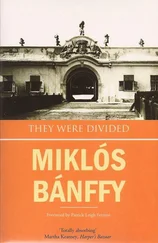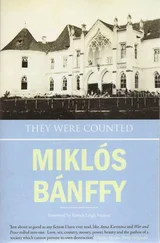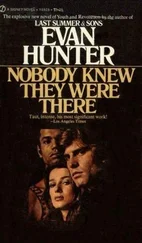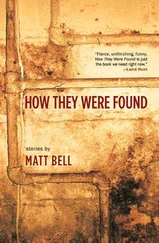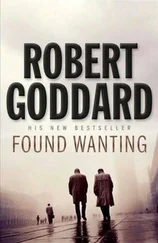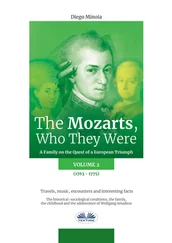‘What a wonderful portrait!’ cried Balint enthusiastically. ‘And what a superb likeness!’
Crookface did not answer, but merely puffed more smoke from his cigar.
‘Who is it by? I never saw such exquisite work,’ he went on, looking at his host.
‘Oh, some Frenchman or other,’ he murmured.
‘But what an interesting dress! I suppose the Countess had it for some costume ball?’
The old man sat back, but he said nothing. Balint got up to look at the picture more closely. Standing slightly to one side he noticed that the lamplight revealed a long scar across the picture all the way from the right shoulder down to the left hip where the carefully concealed blemish was hidden in a cluster of little painted nosegays. There had obviously been a most skilful repair, probably from behind the canvas, but the long rip was still just visible. Balint was about to ask his host about this, but something held him back. He knew that Crookface would not take kindly to cross-questioning — indeed no one ever dared ask him anything — and so he held his tongue, sat down again and just went on staring at the picture.
There was something else mysterious about that painted face, Balint thought, noticing now what a sensuous mouth the lady had, something he had not really remarked when she had been in the room.

For some time neither of them spoke: both were looking at the picture on the wall in front of them. Then suddenly old Crookface said, ‘How is Laszlo Gyeroffy?’
Abady was amazed. Whatever could be the connection, he wondered? Why, out of the blue, should the old man suddenly mention Laszlo?
Of course there was a connection, and a most intimate one, though Balint could hardly be expected to know what it was. The portrait was not of Crookface’s wife, but of Julie Ladossa, Laszlo’s mother. Her portrait had been painted in Paris by the celebrated Cabanel, then the most fashionable of contemporary portraitists. For barely a year it had hung in the hastily arranged temporary drawing-room, upstairs at Szamos-Kozard, where cobwebs and a rusty nail still showed where it had been placed. It was the picture at which Laszlo’s father had struck and then thrown away in his rage and grief at his wife’s desertion … and that was why it had that terrible tear from shoulder to hip.
How it had found its way to Sandor Kendy’s was never revealed. It was a mystery to which nobody but he knew the answer. Was it mere chance, or was there a history of secret searches and even more secret deals? Was the torn masterpiece rescued by the local store-owner, only to be sold, discreetly, later? No one knew.
There were many other secrets tied to this picture too; old passions, yearning desires, misunderstandings, the conflicts of pride and disappointment, and, above all, the gnawing regret for what ought to have been but never was.
Many years after the scandal of Countess Gyeroffy’s flight and her husband’s death in the woods Sandor Kendy had had some business with a lawyer at Haromszek. There he met the lawyer’s niece, Alice Folbert, who was the living double of Julie Ladossa. When Crookface saw the young Alice it was as if he met again the woman he had loved twenty years before. He did not mind that the girl was already extremely deaf and was likely to become even more so; indeed, it was rather an encouragement for him, for it made the girl seem all the more impersonal. She did not need, or want, to be spoken to. Indeed it was neither necessary or possible. All he had to do was to watch her, to gaze and wonder, and observe how she held herself, how she walked, how she moved her shoulders, how she bent over her needlework, how she looked and how she smiled, always without a word. She was there, and yet she wasn’t. She was a symbol, a dream, a ghost; and yet she was flesh and blood and real and he could play for her the old tunes which he never could for the other one and never, never, could she destroy the illusion by some unfortunate remark which would shatter the spell.
As for that other one, the proud, faithless, uncompromising one, to whom he had so longed to play Chopin during those long winter evenings, had she ever seen, or glimpsed, the delicate mimosa soul behind the rough armour of his reserve?
For the rest of the world Sandor Kendy was a hard, hard man who might have been hewn from rock.

‘Laszlo Gyeroffy?’ answered Balint at last. ‘The poor fellow is in a bad way. It seems that he’s granted a lease on his properties in return for ten years’ rent in advance, though maybe he still gets some paltry little sum each month. But I’ve heard that many of his old debts have never been settled and so he’s gradually being sold up and now, apparently, what he’s still got is to be auctioned. The trouble is that he’s drinking and doesn’t care a damn what happens to him.’
Crookface said nothing for a moment; he was still looking at the picture. Finally he said, ‘What an idiot! And no one can make him see reason?’
‘He won’t listen to anyone. I’ve tried, several times, in vain. And he’s avoided me ever since. It’s a sort of suicide, what he’s doing to himself. His only hope is to be made a ward of court. That might save him, but there’s no one to do what’s necessary as he doesn’t have any parents or brothers; and no one else has the right to act.’
‘Bloody fool!’ said Crookface, and fell silent again. After a little while he got up and said, ‘Time for bed. It’s late. You’ll have to get up early to catch the morning train. I’ve ordered the car for six. That’ll get you to Hejjasfalva in time to catch the express.’
Old Kendy showed Balint to a guest-room which was near the drawing-room just beyond the corridor. There he said goodbye, turned away and left quickly. There was no question of continuing their conversation.
Balint found it difficult to sleep. On the other side of the wall of his room he could hear heavy footsteps walking to and fro, resounding in the empty space of the great drawing-room: it was old Kendy, cigar in mouth, pacing up and down the room from the glass doors to the windows and back, again and again.
EIGHT PAIRS of perfectly matched Lipizzaners trotted down the arrow-straight country road.
They were splendid horses, all dapple greys which could have been cast from the same mould, the only difference being that the older ones were slightly lighter in hue and the younger darker with more pronounced shading. They all had the same prancing movement, with their forelegs bending up well in front of them. This, of course, they had been trained to do, not for speed but for beauty and elegance and in fact their progress was comparatively slow. The eight carriages they drew were also identical, painted black with yellow roofs and upper-work. The coachmen wore grey livery and black top hats and they were all of similar build, broad-shouldered and clean-shaven. They too kept perfect rhythm and the fifteen metre distance between each carriage was never varied. Inside each carriage there was one male guest, who was one of the guns invited to the shoot, and in several there were also some ladies. And so, in stately procession, they passed along the acacia-lined country road. When one of the carriages reached its destination — which was marked by a bale of straw whose prominently displayed number corresponded to that accorded to the guest in the carriage, and where that guest’s loader, cartridge carrier and game collector were already waiting — then it pulled aside and stopped and allowed the other carriages to go on their way.
Читать дальше
